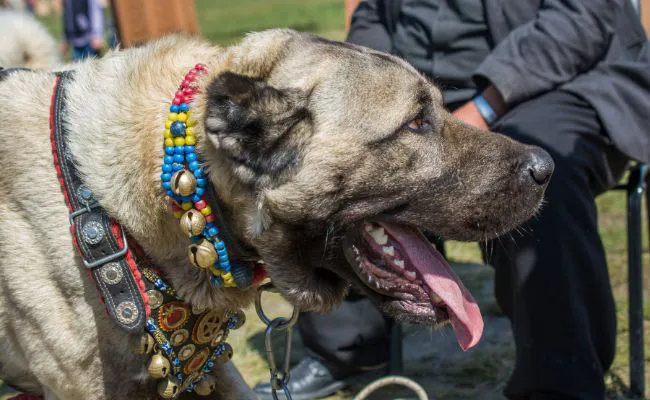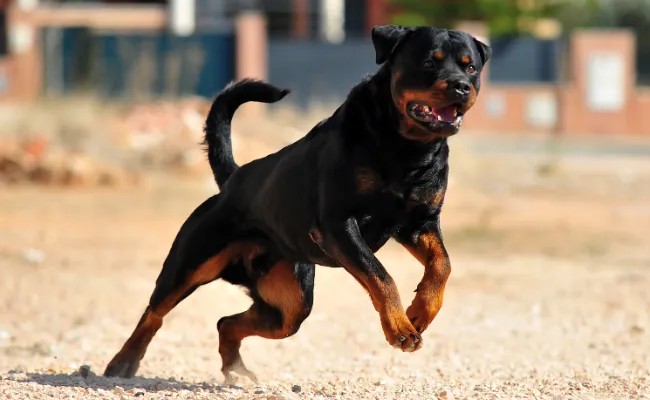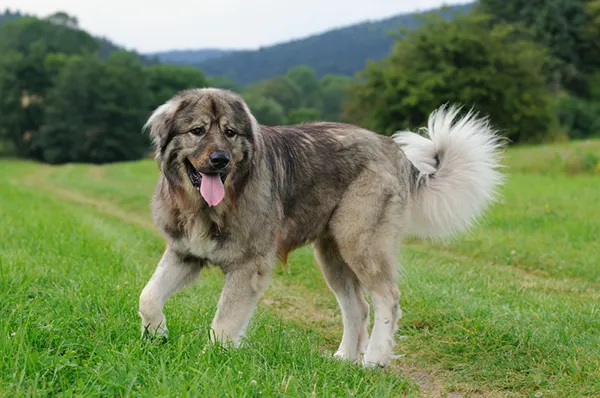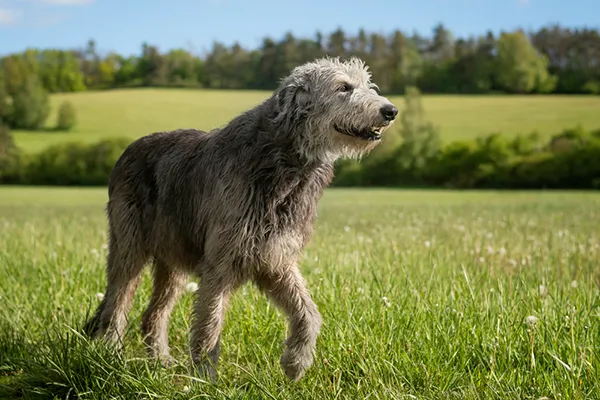
If we talk about a dog’s “strength,” we should remember that “strength” can be measured in many ways, such as bite force, physical power, endurance, and even mental toughness. While Pit Bulls stand out for their agility and tenacity, the question arises: what dog is stronger than a Pitbull? Check out an interesting comparison of dog breeds that may be stronger than Pit Bulls in different ways. This shows how complex and varied dogs’ skills are.
1. Kangal

The Kangal, which comes from Turkey, is often said to be bigger than a Pit Bull for a number of reasons, including its size, ability to breed, bite force, and personality. To understand why Kangals are thought to be better, let us look at these points:
Size and Physical Build
- Kangals are significantly larger and more muscular than Pit Bulls. Adult male Kangals can weigh between 110 and 145 pounds (50 to 66 kg) and stand 30 to 32 inches (76 to 81 cm) tall at the shoulder. Their size gives them a natural advantage in terms of raw physical strength.
- Pit bulls, on the other hand, are medium-sized dogs, with males typically weighing between 35 and 65 pounds (15 to 29 kg) and standing about 18 to 21 inches (45 to 53 cm) tall. Though Pit Bulls are muscular and strong for their size, they don’t match the sheer mass of Kangals.
Bite Force
- One of the most frequently cited measures of a dog’s strength is its bite force, measured in pounds per square inch (PSI). Kangals have one of the highest recorded bite forces among dog breeds, with estimates ranging up to 700 PSI. This powerful bite is a result of their strong jaws and large heads, designed to hold and subdue large predators like wolves and bears.
- Pit Bulls also have a strong bite, estimated at around 235 to 250 PSI, which is formidable for their size but still significantly less than that of a Kangal.
Breeding Purpose
- Kangals were bred to guard livestock against large predators in the rugged terrain of Turkey. This breeding purpose necessitated a dog that was not only strong and capable of fierce combat but also independent and intelligent enough to make decisions in the absence of humans. Their strength is not just physical but also mental, and they are capable of strategic thinking during confrontations.
- Pit Bulls were originally bred for bull-baiting and later became farm dogs and family companions. While they are undoubtedly strong and courageous, their breeding wasn’t focused on the need to confront large predators alone, which influences the type of strength they possess.
Temperament and Endurance
- Kangals have a calm and controlled temperament but can display formidable aggression and strength when protecting their flock. Their endurance is remarkable, capable of covering large distances to patrol and defend their territory.
- Pit Bulls are known for their tenacity, agility, and muscle density. They possess great endurance for their size and can be incredibly persistent. However, their stamina and physical capabilities are tailored more towards activities that match their size and historical roles.
In short, while Pit Bulls are strong, agile, and tenacious, Kangals surpass them in terms of size, bite force, and the specific type of strength required for their traditional role of guarding livestock against large predators. This doesn’t make one breed better than the other; instead, it highlights how different breeds excel in various areas based on their historical roles and physical characteristics.
Related Post: Muscular Pitbull | Turn Your Pitbull into a Muscular Marvel
2. English Mastiff

One clear reason why the English Mastiff is thought to be stronger than the Pit Bull is that it is related to several other things. Some of these factors are their size, muscle strength, and the reason why each breed was created. Let us take a closer look at these points:
Physical Size and Muscle Mass
- English Mastiffs are one of the largest dog breeds in the world, not just in terms of height but significantly in weight and overall mass. They can weigh anywhere from 120 to 230 pounds or more, with some males reaching up to 250 pounds. Their sheer size contributes to their strength, giving them a natural advantage in physical confrontations.
- Pit Bulls, in contrast, are much smaller, with an average weight range of 35 to 65 pounds for males. While Pit Bulls are muscular and agile, their smaller size means they have less body mass and muscle to leverage in physical tasks compared to a Mastiff.
Bite Force
- English Mastiffs possess a strong bite force, which, while not as high as some guardian breeds like the Kangal, is still formidable due to their massive jaws and heads. Their bite force is estimated to be around 500 to 550 pounds per square inch (PSI), which is a reflection of their strength and ability to hold onto something firmly.
- Pit Bulls have a strong bite force for their size, estimated at about 235 to 250 PSI. Although impressive and indicative of their muscular jaws, it is significantly less than that of an English Mastiff.
Breeding Purpose and Temperament
- English Mastiffs were originally bred for guarding and protection, which required both physical strength and a calm, dependable temperament. Their size and strength made them excellent at deterring intruders and protecting estates. This historical role required a dog that could physically overpower or intimidate threats, contributing to the breed’s development towards immense size and strength.
- Pit Bulls were bred for a variety of roles, including bull-baiting and later as farm dogs and companions. Their breeding emphasized agility, tenacity, and muscular strength in a more compact form suited for dynamic movements and endurance rather than the sheer overpowering force that characterizes the English Mastiff.
Endurance and Agility
- While English Mastiffs are strong, their size can limit their endurance and agility compared to smaller, more athletic breeds. They are capable of short bursts of speed and power but are not designed for prolonged physical activity.
- Pit Bulls excel in agility and endurance and are capable of sustained physical activity and agility tasks. Their strength is more dynamic, allowing them to excel in activities that require speed, agility, and endurance.
In short, the English Mastiff’s greater strength compared to a Pit Bull can be attributed to its massive size, significant muscle mass, and bite force that reflects its physical capability. Their breeding as guardians and protectors has resulted in a dog with a body built for strength and intimidation. However, strength is only one aspect of a breed’s characteristics, and different breeds excel in areas suited to their historical roles and physical attributes.
3. Rottweiler

When comparing Rottweilers and Pit Bulls in terms of strength, you have to look at a lot of things, like how they look, how long each breed has been around, and the strengths that each breed brings to the table. Here are some of the reasons why Rottweilers are often thought to be bigger than Pit Bulls:
Physical Build and Size
- Rottweilers are larger and heavier than pit bulls, with males typically weighing between 95 and 135 pounds and standing about 24 to 27 inches tall at the shoulder. This size advantage contributes to their overall physical strength, allowing them to exert more force.
- Pit Bulls are relatively smaller, with males usually weighing between 35 and 65 pounds and standing 18 to 21 inches tall. While Pit Bulls are muscular and agile, their smaller size compared to Rottweilers means they have less mass to leverage in physical tasks.
Bite Force
- The Rottweiler has one of the highest bite forces among dog breeds, estimated at around 328 pounds per square inch (PSI). This powerful bite is a significant indicator of their strength, enabling them to hold and subdue objects (or threats) effectively.
- The Pit Bull also has a strong bite, with a force estimated at around 235 to 250 PSI. Although formidable, it’s lower than that of the Rottweiler, reflecting the difference in their physical capabilities in this aspect.
Breeding History and Purpose
- Rottweilers were originally bred for herding livestock and pulling carts for butchers, tasks that required significant strength and endurance. This history has influenced their development into strong, resilient dogs capable of heavy-duty work.
- Pit Bulls have a history that includes roles such as bull-baiting, farm work, and companionship. Their breeding has emphasized agility, tenacity, and muscular strength, focusing on a balance of power and athleticism rather than sheer physical force alone.
Temperament and Training
- Rottweilers are known for their confidence and assertiveness, traits that, when combined with their strength, make them formidable guardians. Their strength isn’t just physical; it’s also in their presence and demeanour, backed by a willingness to protect.
- Pit Bulls are celebrated for their determination, loyalty, and courage. They are incredibly strong for their size, and while they might not match a Rottweiler in raw physical strength, they possess a tenacious spirit.
Endurance and Agility
- Rottweilers have good endurance and are capable of sustained effort, which is necessary for the protective and working roles they often fill. Their stamina complements their strength, enabling them to complete difficult tasks effectively.
- Pit Bulls are known for their high energy levels and agility, excelling in activities that require endurance and flexibility. Their strength is dynamic and suited for activities that demand both power and agility.
In short, while both Rottweilers and Pit Bulls are strong breeds, Rottweilers have a physical and historical edge that contributes to their perception as being stronger. Their larger size, powerful bite, and breeding for demanding physical tasks all play a role in this comparison. However, it’s important to remember that strength is just one aspect of a breed’s character, and both Rottweilers and Pit Bulls have unique qualities that make them beloved by their owners.
4. Saint Bernard

When comparing the strength of Saint Bernards and Pit Bulls, you have to look at more than just how hard they bite. You have to look at the physical and historical traits that make them seem strong. It is because of these reasons that Saint Bernards are often thought to be stronger:
Size and Physical Build
- Saint Bernards are significantly larger than Pit Bulls, with males typically weighing between 140 and 180 pounds (64 and 82 kg) and some even exceeding 200 pounds (90 kg). They stand about 28 to 30 inches (71 to 76 cm) tall at the shoulder. Their massive size contributes to their overall strength, allowing them to perform tasks that require brute force, such as pulling heavy loads.
- Pit Bulls, on the other hand, are much smaller, with males generally weighing between 35 and 65 pounds (15 to 29 kg) and standing about 18 to 21 inches (45 to 53 cm) tall. While they are muscular and agile, their smaller size means they have less mass to leverage in physical tasks compared to Saint Bernard’s.
Bite Force
- Saint Bernard Bite Force: As estimated, Saint Bernards have a bite force ranging between 230 to 250 PSI (pounds per square inch). This strong bite force is reflective of their large size, strong jaws, and muscular build. While not the highest among dog breeds, it is significant and indicates the potential power behind their bite.
- Pit Bull Bite Force: Pit Bulls are known to have a bite force in a similar range, often cited around 235 to 250 PSI. Given their smaller size compared to Saint Bernard’s, this bite force is remarkably strong relative to their body size and is a testament to their muscular build and jaw strength.
Despite the size difference, Saint Bernards and Pit Bulls have similar bite forces. Saint Bernards, being larger, naturally have a strong bite, aligned with their role as rescue dogs needing both power and gentleness. Pit Bulls, though smaller, exhibit a comparable bite force, showcasing their muscular build, agility, and versatility for various tasks beyond their size.
Overall Physical Capabilities
- The sheer physical size and mass of Saint Bernards give them an edge in raw strength, allowing them to exert more force in tasks such as pulling or carrying heavy loads. Their bodies are built for endurance in challenging environments like deep snow and rough terrain.
- Pit Bulls are incredibly strong for their size, with a significant bite force and a muscular build that allows for impressive agility and endurance. However, their capabilities are more aligned with activities that require speed, agility, and sustained effort rather than brute strength.
5. Caucasian Shepherd

Many people think the Caucasian Shepherd is stronger than the Pit Bull for a number of reasons. The Shepherd is known for being big and strong. These reasons come from differences in their looks, breed history, and intended use. All of these things add to the Caucasian Shepherd’s reputation for being strong.
Size and Physical Build
- Caucasian Shepherds are one of the largest dog breeds, with adult males often weighing between 110 and 220 pounds (50 to 100 kg) and standing 25 to 30 inches (64 to 76 cm) at the shoulder. Their large size is complemented by a muscular and robust build, giving them a significant advantage in raw physical strength.
- Pit Bulls are much smaller and lighter, with adult males typically weighing between 35 and 65 pounds (15 to 29 kg) and standing 18 to 21 inches (45 to 53 cm) tall. While they are muscular and agile, they do not have the same mass and size that contribute to the Caucasian Shepherd’s strength.
Bite Force
- Caucasian Shepherds have a powerful bite, one of the strongest among dog breeds, though specific PSI numbers can vary. Their large jaws and strong teeth enable them to grip and hold onto large predators or intruders, a necessity in their traditional role as livestock guardians.
- Pit Bulls also have a strong bite force for their size, estimated at around 235 to 250 PSI. However, it’s not just the force but the size and strength of the Caucasian Shepherd that make its bite more formidable in comparison.
Breeding History and Purpose
- Caucasian Shepherds were bred for the challenging role of protecting livestock from large predators like wolves and bears in the Caucasus Mountains region. This required a dog not only with significant strength but also with the courage and tenacity to confront and deter large animals.
- Pit bulls were bred to be quick, tough, and muscular. They have a history of being used to scare bulls and, later, as field dogs and pets. Their breeding focused on creating a powerful dog in a more compact and agile form.
Temperament and Protective Instinct
- Caucasian Shepherds are known for their fearless and protective nature. Their strong protective instinct, combined with their size and strength, makes them formidable guardians of their territory and charges.
- Pit Bulls are loyal, courageous, strong for their size, and have a notable determination. However, their protective instincts and strength are packaged in a body built for agility rather than the brute force and intimidation factor of the Caucasian Shepherd.
In short, the Caucasian Shepherd’s greater strength compared to the Pit Bull is primarily due to its larger size, more powerful build, and the specific demands of its traditional role as a guardian against large predators. These factors contribute to its reputation as being stronger, particularly in terms of physical power and protective capabilities.
6. Irish Wolfhound

Irish Wolfhounds are often considered stronger than Pit Bulls primarily due to their significant size advantage, physical build, and the historical roles they have been bred for. These factors contribute to their overall strength in several ways:
- Size and Physical Build: Irish Wolfhounds are one of the tallest dog breeds, with adult males typically standing at least 32 inches tall at the shoulder and weighing around 140 to 180 pounds. This large size and strong build provide them with a natural advantage in physical strength over smaller breeds like pit bulls, which generally weigh between 35 and 65 pounds and stand 18 to 21 inches tall.
- Bite Force: The Irish Wolfhound is estimated to have a bite force of around 350 PSI, indicating a strong bite that complements their large size and hunting heritage. In comparison, the Pit Bull’s bite force is estimated at 235 to 250 PSI, which is notably powerful for their smaller size, showcasing their muscular build and jaw strength. Despite the difference in size between the two breeds, both possess significant bite forces that reflect their respective physical capabilities and breeding histories.
- Breed Purpose: Historically, Irish Wolfhounds were bred for hunting large game, such as wolves and elk. This required not only size and strength but also speed, endurance, and the ability to work in rugged terrain. Their physical capabilities were developed to tackle and overpower large animals, a trait that underscores their strength.
- Physical Capabilities: The sheer physical size of Irish Wolfhounds allows them to cover ground quickly and exert powerful movements. Their long legs and strong muscles enable them to perform tasks that require significant force, such as pulling down large games during hunts.
In comparison, while Pit Bulls are known for their muscular build, tenacity, and strong bite force, they do not match the Irish Wolfhound in terms of size and the raw physical strength that comes with being a larger breed. Pit Bulls excel in agility and endurance, showcasing remarkable power for their size, but in terms of brute strength and the ability to perform heavy physical tasks, Irish Wolfhounds have the advantage.
7. Alaskan Malamute

Alaskan Malamutes are often considered stronger than Pit Bulls for several reasons, mostly related to their size, breed history, and physical capabilities. Here’s a breakdown of why Malamutes are seen as having greater strength:
Size and Physical Build
- Alaskan Malamutes are significantly larger and heavier than Pit Bulls. They typically weigh between 75 to 85 pounds for females and 85 to 100 pounds for males, with some individuals exceeding this range. They stand about 23 to 25 inches tall at the shoulder. This larger size means more muscle mass, contributing to their overall strength.
- Pit Bulls, in comparison, are smaller, with weights ranging from 30 to 65 pounds and heights of 17 to 21 inches at the shoulder. While they are muscular and agile, they don’t have the same mass as Malamutes.
Breed Purpose and History
- Alaskan Malamutes were bred for pulling heavy sledges over long distances in harsh Arctic conditions. This required immense strength, endurance, and a robust build. Their historical roles demanded a powerful physique capable of heavy-duty work.
- Pit Bulls have a diverse background that includes roles such as bull-baiting, farm work, and companionship. Their breeding focused on agility, tenacity, and muscular strength rather than the brute force required for pulling heavy loads.
Physical Capabilities
- Alaskan Malamutes possess great pulling power, a direct result of their muscular build and large frame. They are capable of hauling heavy freight for miles, showcasing their remarkable strength and stamina.
- Pit Bulls are known for their strength relative to their size, impressive bite force, and muscular build. They excel in activities that require agility, speed, and power but do not have the same physical capabilities for tasks like heavy pulling that Malamutes do.
Endurance and Stamina
- The Alaskan Malamute is equipped with endurance for long-distance work in challenging conditions, a testament to their overall physical strength and resilience.
- Pit Bulls also display endurance, particularly in activities that match their size and physical abilities. However, their endurance is of a different nature, more suited to agility and speed rather than the prolonged heavy labour for which Malamutes are built.
In short, Alaskan Malamutes are considered stronger than Pit Bulls due to their larger size, significant muscle mass, and historical breeding purposes that have equipped them with the strength for heavy pulling and endurance tasks. While Pit Bulls are undoubtedly strong and agile, their strength is showcased differently, suited to their size and historical roles.
Conclusion
Each of these breeds excels in different areas of strength. For instance, while a Kangal might have a stronger bite, a Saint Bernard might outmatch others in sheer body mass and pulling strength. It’s also crucial to remember that strength is just one aspect of a dog’s character and capabilities, and factors like temperament, loyalty, and trainability are equally important in determining a dog’s suitability for specific tasks or as a companion.



